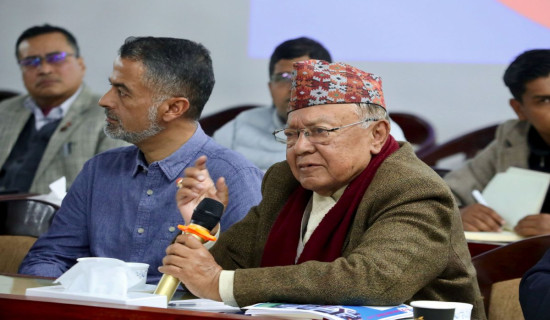- Monday, 22 December 2025
Cultural Issues And Mediation
The significance of intercultural issues figured prominently in the New Delhi meet of alternative dispute resolution held recently in which jurists and law practitioners from Nepal had participated. Of course, Nepal is a cultural turn table of Asia as it is endowed with a rich treasure of cultural and natural diversity, beauty and resources. When we talk of the major ingredients of culture, the UNESCO definition captures some of its major aspects, dimensions and elements. UNESCO describes culture as ‘the whole complex of distinctive spiritual, material, intellectual and emotional features that characterise a society or social group. It thus includes not only arts and letters, but also modes of life, value systems, traditions and beliefs’.
From the perspective of culture defined by UNESCO, among others, there is no overstating the fact that Nepal is one of the richest nations in the world in terms of natural pageantry and cultural diversity. This may be due to its unique geographical setting and convergent location with convenience of movement from both the north and the south. As a result, both Caucasoid and Mongoloid races and cultures, among others, meet, interact and mingle in a very harmonious setting in an almost equal degree and proportion.
Nepal, in fact, offers the cultural microcosm of almost whole of the Asian continent, not to speak of the Asia Pacific nations. When we talk about the alternative dispute resolution especially mediation and arbitration, therefore, mediation service providers need to be sensitive to cultural sensibilities. Not only this training curricula for mediation introduced by Nepal Mediation Council, an apex regulating body headed by justice of the Supreme Court, should contain lessons on intercultural issues in mediation as well.
Core values
The federal democratic constitution of Nepal, 2015 in its preamble recognises the country as a multicultural state with a rich mosaic of diverse cultural groups and sub-groups who speak several different languages and observe different cultural rituals, norms and values. The constitution also enshrines cultural right as the fundamental right of the citizens. Nepal is one of the first countries in South Asia probably next to Sri Lanka where an umbrella Mediation Act embracing core values and principles of mediation is functional for almost a decade. Moreover, the constitution and the relevant laws, including the Local Government Operation Act itself, provide for mediation panels at the local level under the purview of local judicial committee with management and budgetary support of the local government.
Under federal framework, the country has been reorganised into seven provinces and seven hundred fifty three local government institutions endowed with constitutionally assigned and scheduled functions and mandates. Each ward of the seven hundred fifty three local governments should have one community mediation centre staffed with at least three to five community mediators trained and certified by Mediation Council through the accredited training organisations.
Judicial mediation is also institutionalised in Nepal through an enshrinement of relevant chapters in the Supreme Court, High Court and district court rules. However, making these provisions effective to deliver results remains a big challenge. Commercial mediation is yet to take shape in Nepal though its uses and advantages are widely discussed.
Nepal is yet to ratify the Singapore Mediation Convention. Nepal Law Commission has already presented an advisory note to the government on the need for its ratification. Nepal International ADR Centre, among other civil society groups, has taken advocacy initiatives and sought engagement with the government for early ratification of the Singapore treaty. Singapore convention on Mediation aims at guaranteeing the enforceability of the commercial dispute settlement agreements arrived at through are course to mediation. The mediation settlement agreement must be related with commercial disputes, among others.
The flexibility and diversity of the mediation process means that it is perhaps better able to appropriately meet the needs of a culturally diverse Asia Pacific region which is not possible in other dispute resolution processes and systems. In fact, irrespective of whether we are dealing with disputing parties in international, transnational, cross-border or domestic disputes, we have cross-cultural or intercultural issues to manage attend and address.
Cross-cultural disputes are often characterised by parties having different goals, bargaining styles and modes of communication. Moreover, the parties to the disputes may have varying levels of emotionalism, approaches to the form of agreements, perspectives to problem solving, approaches to settlement authority and views as to risk taking. In light of the diversity of conflicts, circumstances, parties, and other relevant factors in any given case, there cannot be any one correct approach to mediation.
Sensible techniques
There is no prescriptive formula for how the mediation process must be delivered in varying jurisdictions. The practice of using co-mediators may be particularly useful for multi-party mediations since it provides a useful means of bringing in more specific skills and experiences. Though standard portfolio may not be easy to prescribe, there are a range of quite sensible techniques and tools that mediators shall use to bridge cross-cultural differences in commercial mediation to further the spirit of the UN convention on mediation. Mediators need to be sensitive to cultural dimensions and understand how one’s own culture and life experience fits to these dimensions. Likewise, they need to do some research into the cultures from which disputing parties themselves come from. Nonetheless, this research will need to be done carefully so as to gather information about the way business relationships are formed and business disputes are resolved within the existing cultural environment.
Mediators should enquire with the parties about their cultural contexts and goals to ascertain what matters them most. Finally, accredited trainings or other standard trainings should incorporate cross-cultural mediation issues in their curricula to prepare the competent and culture sensitive mediators to deal with cross border commercial disputes to support and enhance the implementation of the Singapore Convention on mediation.
(The author is presently associated with Policy Research Institute (PRI) as a senior research fellow. rijalmukti@gmail.com)

















